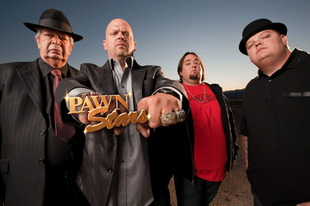Pawn Stars and American Pickers have been two of the most popular shows on cable in the last five years. Since their inception they have spawned numerous offshoots of questionable quality, all helping viewers find hidden valuables and learn how to make cash. But are these shows really accurate portrayals of the antiques and collectibles markets? Are the prices paid fair?
Value versus What Someone Will Actually Pay for It
 One of my favorite scenes in just about every episode of Pawn Stars is when someone brings in an item with a value of what they have in mind, expecting at least that amount otherwise there will be no deal. Where did they get that value in their head? Is it because a price guide told them that was the value, an expert, or was it what they originally paid for it? Often it’s a combination of all three.
One of my favorite scenes in just about every episode of Pawn Stars is when someone brings in an item with a value of what they have in mind, expecting at least that amount otherwise there will be no deal. Where did they get that value in their head? Is it because a price guide told them that was the value, an expert, or was it what they originally paid for it? Often it’s a combination of all three.
The scene unfolds with Rick kindly informing the person trying to make the sale (assuming he’s even interested in the item) that value is only one element and that it will likely sit on a shelf for a long time before someone is even interested in it. Never mind that he has to remind just about everyone that he is a retail establishment and has to make a profit anyways.
The person is perplexed, surprised and often offended but, is Rick being untrustworthy? Not even close. The fact that he is willing to buy many of the items might even show he has heart more than anything. The problem with value on antiques and collectibles is that it means nothing, unless someone is willing to pay that price or any price for that matter.
But my Antiques and Collectibles are Still Worth Something Right?
Maybe, but maybe not. There are literally thousands of different antiques and collectibles that are hardly worth the storage space they maintain. Now of course, that’s from a monetary standpoint. I own plenty of antiques that are monetarily worthless but I hold historically important.
Even those items of incredible rarity have to have a buyer before they’re worth what someone wants to sell them for. Remember the episodes with the Civil War token encased postage stamp or the early Benjamin Franklin Continental Currency? These were both items Rick had to have both for their incredible historic and monetary value. What the show failed to illustrate is that the market for these is not as large as you would imagine.
Sure, numismatists (coin collectors) are a passionate group that are casually said to number more than 300,000 in the United States alone but not all of them have the disposable income to pay for these items. Do you know many people that are willing to shell out $800 for an encased postage stamp? Those that are, probably can afford an even better one, or the best one. What then?
Times are Different and Antiques and Collectibles need to be Approached Appropriately
Pawn Stars has been largely successful because it has given hope to this post recession audience, that there is hidden money in our home and garage sales. It gives hope that people are still spending money on leisure activities like collecting hobbies. It gives the impression that these items are hot and there are buyers. But are there buyers? Sure, but to the degree the show might have you believe?
If you have antiques or collectibles you would like to sell the best advice is to get a professional appraisal or take the time to learn as much as you can to get the appropriate value. If they’re hardly worth the time and effort, don’t kid yourself. Get rid of them or appreciate what they are besides their monetary value.
Want to buy in this market? You’re quite lucky because there are more and more opportunities now that everyone knows they can sell their old stuff. In a later post I’ll detail how to prepare yourself and educate yourself to get the best bang for your buck.